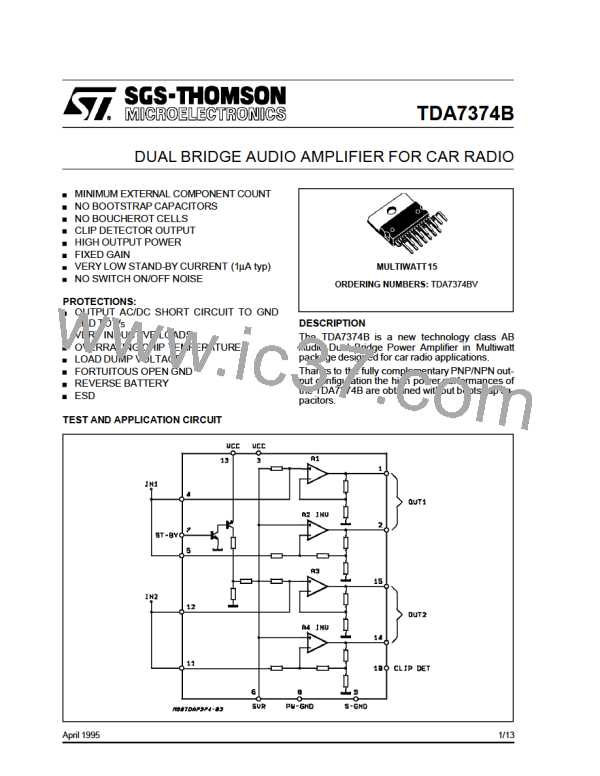TDA7374B
loss on the top side of the waveform. This unbal-
anced saturation causes a significant power re-
duction. The only way to recover power consists
of the addition of expensivebootstrap capacitors.
OUTPUT STAGE
The fully complementary output stage was made
possible by the development of a new compo-
nent: the ST exclusive power ICV PNP.
A novel design based upon the connection shown
in fig. 13 has then allowed the full exploitation of
its possibilities.
2 - Absolute Stability Without Any External
Compensation.
Referring to the circuit of Fig. 13 the gain
VOUT/VIN is greater than unity, approximately 1 +
R2/R1. The DC Output (VCC/2) is fixed by an aux-
iliary amplifier common to all the channels).
Figure 13: The new Output Stage
By controlling the amount of this local feedback it
is possible to force the loop gain (A * β) to less
than unity at frequency for which the phase shift
is 180 Deg. This means that the output buffer is
intrinsically stable and not prone to oscillation.
Most remarkably, the above feature has been
achieved in spite of the very low closed loop gain
of the amplifier.
In contrast, with the classical PNP-NPN stage,
the solution adopted for reducing the gain at high
frequencies makes use of external RC networks,
namely the Boucherot cells.
OTHER OUTSTANDING CHARACTERISTICS:
Clipping Detector Output
The clear advantages this new approachhas over
classical output stages are as follows:
The TDA7374B is equipped with an internal cir-
cuit able to detect the output stage saturationpro-
viding a proper current sinking into a open collec-
tor output (pin 10) when a certain distortion level
is reached at each output.
1 - Rail-to-Rail Output Voltage Swing With No
Need Of Bootstrap Capacitors.
The output swing is limited only by the Vcesat of
the output transistors, which are in the range of
0.6 Ohm each.
Classical solutions adopting composite PNP-NPN
for the upper output stage have higher saturation
This particular function allows gain compression
facility whenever the amplifier is overdriven, thus
obtaininghigh quality sound at all listening levels.
Figure 14: Clipping Detection Waveforms
7/13

 STMICROELECTRONICS [ ST ]
STMICROELECTRONICS [ ST ]